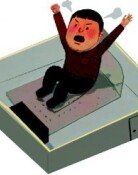[Op-Ed] CD Rates Finger Counted?
The official interest rate for three-month certificates of deposit announced Friday was 2.91 percent a year, the highest in eight months. With little market transactions between Sept. 28 and Friday, the rates gradually rose 0.01 percentage point per day. CD rates are closely related to daily life because 60 percent of household loans and 40 percent of lending to small and medium companies use them as the benchmark rates. Banks also determine interest rates for mortgage loans by adding a premium to CD rates. This is why many people keep a close watch on changes in CD rates. The rates rose 0.4 percentage point over the last two months. As a result, the loan interest rate burden facing households and small companies has snowballed to more than two trillion won (1.7 billion U.S. dollars) a year.
CD rates are determined by the Korea Financial Investment Association from the average rates of 10 securities companies that can reflect the amount of capital circulating in the market. Securities companies, however, are known to have made a rough estimate by looking at market conditions or asking other companies if little CD transactions occurred in a day. This job usually goes to the lowest ranking employees of departments in charge of reporting interest rates because their superiors have better things to do. It is worrisome that something as important as determining CD rates, which greatly affect households, is considered insignificant by securities companies.
In the aftermath of the global financial crisis last year, the Bank of Korea has kept its benchmark interest rate at two percent for the eighth straight month. Unfortunately, the average household does not benefit much from the low interest rate since the mortgage loan rate was 6.34 percent by adding a premium of 1.18 percent to the 2007 average CD rate of 5.16 percent. CD rates dropped to 2.48 percent in August, a fall of 2.68 percentage points from 2007, but the loan interest rate only dropped 0.89 percentage point to 5.45 percent since banks covertly raised premiums in line with the decline in CD rates.
It all went wrong from linking loan interest rates to CD rates when 80 percent of bank loans come from deposits and installments. Since only eight percent of capital comes from CDs, it is not easy for banks to lower loan interest rates in line with the decline of CD rates. This is why the premium was irregularly raised. Kim Ja-bong of the Korea Institute of Finance suggests that the benchmark interest rate for loans should be the weighted average of deposits, financial bonds and CDs instead of CD rates alone. If CD rates are determined by a rule of thumb and fail to qualify as benchmark rates for loans, financial authorities should stop this practice as soon as possible as a means of financing for the people.
Editorial Writer Hong Kwon-hee (konihong@donga.com)







